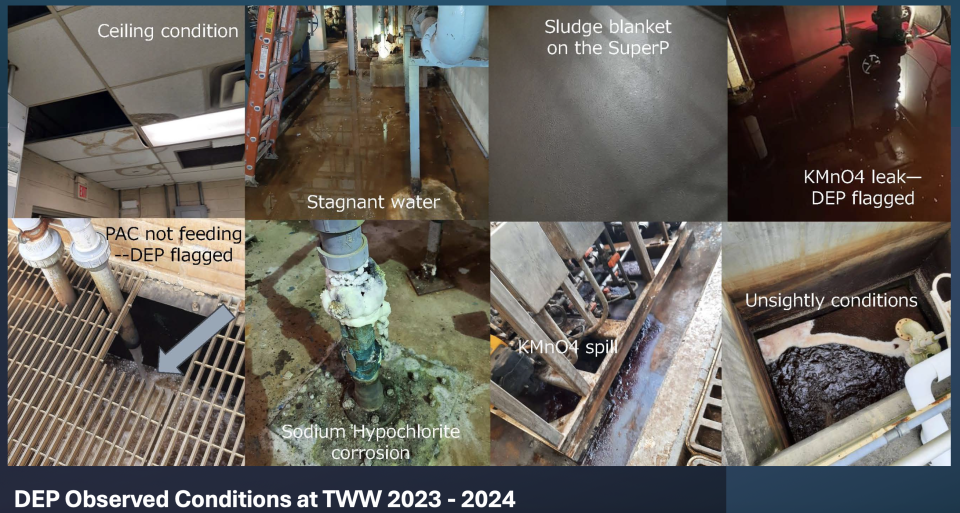Trenton Water Works issued multiple restrictions on water use in January 2025, saying ice in the Delaware River — where it draws drinking water — has blocked water intakes. (Dana DiFilippo | New Jersey Monitor)
In the summer of 1975, Trenton’s public water utility experienced so many failures that its reservoir ran dry and residents had no water, forcing fire trucks to line up for miles to pump water from the suburbs and civil defense to truck in water, too.
The system didn’t fully recover for eight months. In a 1976 report, state environmental officials blamed “human error, equipment failure, and design vulnerability” for causing the crisis.
Advertisement
Advertisement
Fifty years later, little has changed at Trenton Water Works, according to two new independent reports the state Department of Environmental Protection issued Monday.
Dysfunctional government, a “culture of complacency,” and other recurring challenges have put the utility at “extremely high risk of systemic failure,” the department’s commissioner, Shawn LaTourette, told reporters.
The utility, which serves 225,000 customers in the capital city and its suburbs, should be removed from the city’s sole control and reconfigured into a regional authority, LaTourette said.
“The system is still suffering from historic neglect and mismanagement that pre-exists the current gubernatorial and mayoral administrations,” he said. “The only way to recover from that is through restructuring.”
Advertisement
Advertisement
The state declared oversight over the utility in October 2022 after violations piled up for years over the 221-year-old utility’s persisting failure to ensure the safety of the 33 million gallons of water it delivers daily to residents of Trenton, Ewing, Hamilton, Hopewell, and Lawrence.
Monday, LaTourette called on legislators to authorize by statute the establishment of a regional utility.
“DEP cannot provide stability support forever,” LaTourette said. “That is not what this agency does. It is what we are doing here, because it incumbent upon us to ensure the protection of public health. But it is not sustainable in the long term. We have hundreds of water systems to monitor.”
The two reports released Monday, which run 320 pages combined, document all sorts of problems at the utility that the reports’ authors say endanger public health and ratepayer affordability.
Advertisement
Advertisement
More in U.S.
The utility, which draws water from the Delaware River, has a $600 million capital improvement plan that would remove thousands of lead pipes, replace water mains, build a new central pumping station, and replace an uncovered reservoir with decentralized storage tanks.
But the utility doesn’t have the money, the technical know-how, and the management capacity to pull it off, the reports say.
Instead, “there is no evidence” city officials could improve the utility so that it consistently meets regulatory requirements without the state’s oversight and help, one report says.
The utility repeatedly has made headlines in recent years for everything from deadly Legionnaire’s Disease outbreaks to worms in the drinking water to ice buildup to a worker who got away with faking drinking water samples for over a year.
Advertisement
Advertisement
LaTourette showed pictures that underscored systemic problems, including a “sludge blanket” over machinery that removes water contaminants, leaks, spills, stagnant water in utility buildings, and more.
“This is not what a water system should look like,” he said.
Conditions at Trenton Water Works (Screenshot courtesy of New Jersey Department of Environmental Protection)
LaTourette stressed officials don’t want the utility to be sold or privatized, options he called “non-starters.” Instead, he said, it should be restructured to give the suburbs it serves a seat at the table, with its governance structure either a municipal utilities authority, a special purpose entity, or a public-private partnership under municipal ownership.
Professionals “deeply experienced in the water sector” should run its daily operations, he added.
Advertisement
Advertisement
“It should never be the case that a water operator has to ask a city council if they can buy enough chlorine to treat drinking water,” LaTourette said.
Trenton Mayor Reed Gusciora said a shift to regional management deserves serious consideration, especially if that means the suburbs will help share the costs of management, he said.
The utility’s problems have “never been a governance problem. It’s been a resource problem,” he added.
“Here’s the deal — 55% of the customers live outside of Trenton. So should they have a greater say in what happens at Trenton Water Works? Absolutely,” Gusciora said. “We’re going through the process of a $600 million capital improvement plan, and it’s better if the cost is clearly shifted to a regional authority.”
Advertisement
Advertisement
Municipal officials in the suburbs served by the utility have badgered the city for years for a role in managing the utility. Gusciora attributed the city’s refusal to share management duties so far to “pride of ownership.”
“We’ve owned the water works since 1804. We’re the second oldest system” in the country, he said.
While Monday’s reports echo some of the same concerns the state raised in its 1976 report on Trenton’s 1975 water crisis, LaTourette cautioned against pointing fingers.
“Making structural change is really difficult,” LaTourette said. “It’s easier to fix things when they break, as opposed to systematically ensure that they don’t break in the first place.”
Advertisement
Advertisement
LaTourette said shifting to a regional authority is a process that could take years.
Gusciora and the mayors of the suburbs served by Trenton Water Works say they’re already working on it.
They put out a joint statement Monday welcoming a restructuring.
“We, the Mayors of TWW-serviced towns, agree that the status quo is not sustainable, and we believe that creating a new public utility, with governance that allows for greater operational independence and collaboration across municipalities, is a necessary step forward,” said the statement from Gusciora, Jeff Martin of Hamilton, Bert Steinmann of Ewing, Patricia Hendricks Farmer of Lawrence, and Courtney Peters-Manning of Hopewell.
Advertisement
Advertisement
The mayors said they would spend the next six months collaborating to devise a plan for a regional authority. Priorities in those negotiations include fairly compensating Trenton for the utility; assessing any impact on customers’ rates and fees; and crafting a public education campaign on the plan’s impacts, planned repairs and upgrades, and hiring needs.
The mayors said they also want to “restore the public’s faith and confidence” in Trenton Water Works.
LaTourette tried to do that, too. He spent his media briefing Monday sipping from a glass of water.
“I probably drink about 12 glasses of water a day while I am in my office here — and yes, it comes from Trenton Water Works, and no, I have zero concerns about it,” he said. “But that is only because my people are there, and I know they are keeping it stable and that the water quality is consistent with our drinking water standards in the state of New Jersey, which are the strongest in the nation.”
SUBSCRIBE: GET THE MORNING HEADLINES DELIVERED TO YOUR INBOX
EMEA Tribune is not involved in this news article, it is taken from our partners and or from the News Agencies. Copyright and Credit go to the News Agencies, email news@emeatribune.com Follow our WhatsApp verified Channel





